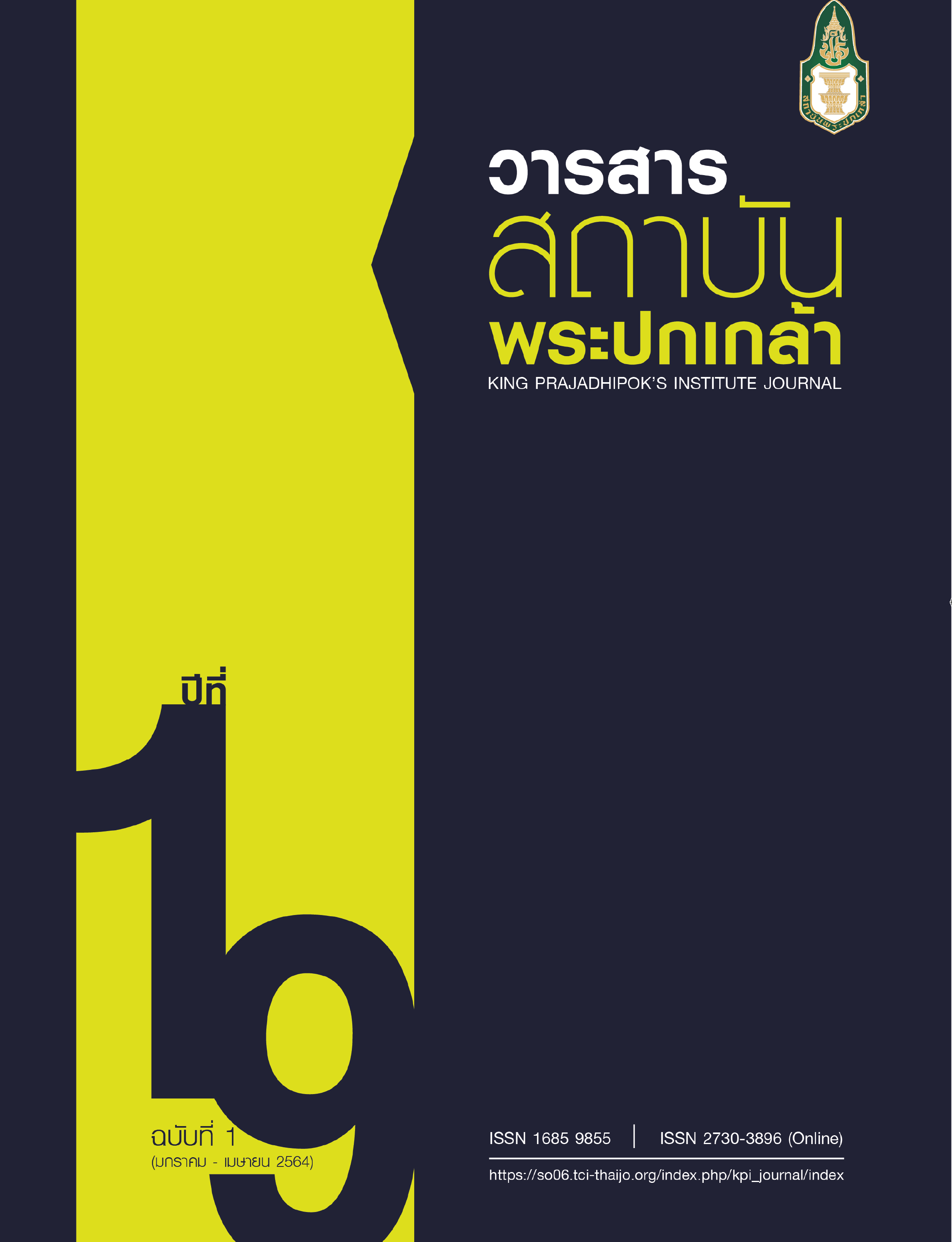Local Government Fiscal Sustainability A Case study of Local Government in Chiang Mai Province, Thailand
Main Article Content
Abstract
This research aims to analyze the fiscal sustainability of local governments in Chiang Mai Province, Thailand, between the fiscal year of 2012-2016 and propose guidelines for enhancing local government financial sustainability. The researcher utilizes a mixed-method sequential explanatory research design with data collected from 81 local governments located in the provincial area. The quantitative results depict that the means of cash solvency, budget solvency, and service-level solvency indices are low, whereas the mean of long-term solvency index is high. The qualitative results approach several guidelines for local fiscal sustainability contingent on four dimensions, including enhancing appropriate local authority, local economic development policy, local competency in structuring institutional policy and fiscal system operation, and administrative capacity for monitoring the fiscal condition. In short, this research illustrates the implementation of such indices, and then it utilizes the results to create suggestions for streamlining the fiscal sustainability of local governments in Thailand.
Article Details

This work is licensed under a Creative Commons Attribution-NonCommercial-NoDerivatives 4.0 International License.
@ 2020 King Prajadhipok's Institute The Government Complex Commemorating All Right Reserved.
References
จรัส สุวรรณมาลา. (2556). ก้าวข้ามกับดัก Hamilton Paradox : สู่จังหวัดจัดการตนเอง. กรุงเทพฯ: คณะรัฐศาสตร์ จุฬาลงกรณ์มหาวิทยาลัย.
ปลัดองค์การบริหารส่วนตำบล. องค์การบริหารส่วนตำบล 80 อำเภอแม่ออน จังหวัดเชียงใหม่. (6 มกราคม 2563). สัมภาษณ์
นายกเทศมนตรี. เทศบาล 36 อำเภอสันทราย จังหวัดเชียงใหม่. (2563, 8 มกราคม). สัมภาษณ์.
นายกเทศมนตรี. เทศบาล 37 อำเภอสันทราย จังหวัดเชียงใหม่. (2563, 6 มกราคม). สัมภาษณ์.
นายกเทศมนตรี. เทศบาล 39 อำเภอสันทราย จังหวัดเชียงใหม่. (2563,8 มกราคม). สัมภาษณ์.
นายกองค์การบริหารส่วนตำบล. องค์การบริหารส่วนตำบล 59 อำเภอแม่อาย จังหวัดเชียงใหม่. (2563, 16 มกราคม). สัมภาษณ์.
นายกองค์การบริหารส่วนตำบล. องค์การบริหารส่วนตำบล 73 อำเภอแม่วาง จังหวัดเชียงใหม่. (2563, 13 มกราคม). สัมภาษณ์.
วีระศักดิ์ เครือเทพ. (2554). การวิเคราะห์ฐานะทางการเงินขององค์กรปกครองส่วนท้องถิ่น: คู่มือสำหรับนักบริหารงานท้องถิ่นในยุคใหม่. กรุงเทพฯ: วิทยาลัยพัฒนาการปกครองท้องถิ่น สถาบันพระปกเกล้า.
วีระศักดิ์ เครือเทพ. (2555). กลยุทธ์การปรับตัวทางการเงินการคลังขององค์กรปกครองส่วนท้องถิ่นภายใต้ภาวะวิกฤติ. กรุงเทพฯ: สถาบันพระปกเกล้า.
วีระศักดิ์ เครือเทพ. (2561). การบริหารงานคลังภาครัฐบนฐานความยั่งยืน. พิมพ์ครั้งที่ 3. กรุงเทพฯ:โรงพิมพ์แห่งจุฬาลงกรณ์มหาวิทยาลัย.
วีระศักดิ์ เครือเทพ และคณะ. (2558). 15 ปี การกระจายอำนาจของไทย: สรุปผลการวิจัยและข้อเสนอแนะเชิงนโยบาย. กรุงเทพฯ: ศูนย์ส่งเสริมนวัตกรรมและธรรมาภิบาลท้องถิ่น.
Baker, D. L. (2005). Strategies for local government fiscal stability: Six strategies public managers must master to stabilize year-to-year variances in local government funding. The Public Manager, 34(4), 31-39.
Benbasat, I., Goldstein, D. K., & Mead, M. (1987). The case research strategy in studies of information system. MIS Quarterly, 11(3), 369-386.
Brown, K. W. (1993). The 10-point test of financial condition: toward an easy-to-use assessment tool for smaller cities. Government Finance Review, 9(6), 21-26.
Burnside, C. (2005). Fiscal sustainability in theory and practice: a handbook (Vol. 396). Washington, DC. World Bank Publications.
Callahan, R. F. (2012). Moving beyond magical thinking: Finding leadership, strategy, and fiscal sustainability in local government. National Civic Review, 101(1), 8-10.
Chapman, J. I. (2008). State and local fiscal sustainability: The challenges. Public Administration Review, 68(s1), S115-S131.
Crosby, A., & Robbins, D. (2013). Mission impossible: Monitoring municipal fiscal sustainability and stress in Michigan. Journal of Public Budgeting, Accounting & Financial Management, 25(3), 522-555.
Flyvbjerg, B. (2011). Case study. In Norman K. Denzin, & Yvonna S. Lincoln (Eds.), The Sage Handbook of Qualitative Research, 4th ed. (301-316). Thousand Oaks, CA. Sage Publication.
Ianchovichina, I., Liu, L., & Nadu, T. (2007). Subnational fiscal sustainability analysis: What can we learn from Tamil Nadu? Economic and Political Weekly, 42(52), 111-119.
Ivankova, N. V., Creswell, J. W., & Stick, S. L. (2005). Using mixed-methods sequential explanatory design: From theory to practice. Field Methods, 18(3), 3-20.
Maher, C. S., & Nollenberger, K. (2009). Revisiting Kenneth Brown’s “10-Point Test.” Government Finance Review, 25(5), 61-66.
Stone, S. B., Singla, A., Comeaux, J., & Kirschner, C. (2015). A comparison of financial Indicators: The case of Detroit. Public Budgeting & Finance, 35(4), 90-111.
Wang, X., Dennis, L., & Tu, Y.S. (2007). Measuring financial condition: A study of U.S. states. Public Budgeting & Finance, 27(2), 1-21.
Ward, R. B., & Dadayan, L. (2009). State and local finance: Increasing focus on fiscal sustainability. Publius: The Journal of Federalism, 39(3), 455-475.


